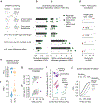Reproducibility metrics for context-specific CRISPR screens
- PMID: 37201508
- PMCID: PMC10266068
- DOI: 10.1016/j.cels.2023.04.003
Reproducibility metrics for context-specific CRISPR screens
Abstract
CRISPR screens are used extensively to systematically interrogate the phenotype-to-genotype problem. In contrast to early CRISPR screens, which defined core cell fitness genes, most current efforts now aim to identify context-specific phenotypes that differentiate a cell line, genetic background, or condition of interest, such as a drug treatment. While CRISPR-related technologies have shown great promise and a fast pace of innovation, a better understanding of standards and methods for quality assessment of CRISPR screen results is crucial to guide technology development and application. Specifically, many commonly used metrics for quantifying screen quality do not accurately measure the reproducibility of context-specific hits. We highlight the importance of reporting reproducibility statistics that directly relate to the purpose of the screen and suggest the use of metrics that are sensitive to context-specific signal. A record of this paper's transparent peer review process is included in the supplemental information.
Keywords: CRISPR screening; correlation coefficients; genetic interactions; replicate correlation; reproducibility.
Copyright © 2023 Elsevier Inc. All rights reserved.
Conflict of interest statement
Declaration of interests Co-author Brenda Andrews is on the advisory board of Cell Systems.
Figures

References
-
- Meyers RM, Bryan JG, McFarland JM, Weir BA, Sizemore AE, Xu H, Dharia NV, Montgomery PG, Cowley GS, Pantel S, et al. (2017). Computational correction of copy number effect improves specificity of CRISPR–Cas9 essentiality screens in cancer cells. Nat. Genet 49, 1779–1784. 10.1038/ng.3984. - DOI - PMC - PubMed
Publication types
MeSH terms
Grants and funding
LinkOut - more resources
Full Text Sources

